![]() Artworks by Sen + Sonja Sonja's c.v. A tour of Sonja's work via thumbnail images
Artworks by Sen + Sonja Sonja's c.v. A tour of Sonja's work via thumbnail images
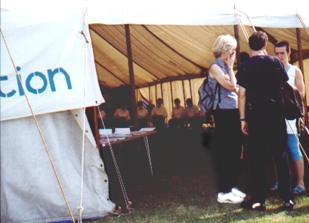
In front of the InterAction Marquee, during the Bermondsey Carnival Inside tent; the performance, Tabula Rasa, May 1999. Em (EMCO) is standing on the far right. |
EMCO, a London-based performance artist, had the idea to create a festival of performance as part of the annual Bermondsey Carnival in Southwark Park, London, U.K., and invited me to participate.
InterAction evolved into a series of performances and installations by 25 European-based artists in and around the park and the Cafe Gallery over a five-day period in May 1999. I decided to invite a number of others to work with me because I was interested in creating a sense of 'community' through performance, rather than an act made by one individual. | ||||||||||||||||||||||||||||||||||||||||||||||||||||||||||||||||||||||||||||||||||||||||||||||||||
|
Our project, The Living Creature consisted of 2 performances, one in the marquee (Tabula Rasa), the other in the rose gardens (The Living Creature), and an installation in the Cafe Gallery. |
|
In the Clare College Mission Church across the green there was another exhibition with much bigger names than ours. It was called, 'Word enough to save a life, Word enough to take a life' and opened on the evening we arrived. The works were mostly installations squeezed in around each other. The names I recognized were Douglas Gordon and Mark Dion. I can't say what I thought of it because there were too many people and I was too busy to go back again. But that event was the start of InterAction for me. |
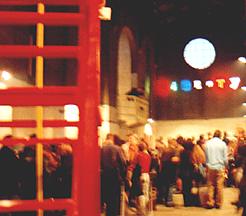
At the opening of 'Word enough to save a life, Word enough to take a life' | ||||||||||||||||||||||||||||||||||||||||||||||||||||||||||||||||||||||||||||||||||||||||||||||||||
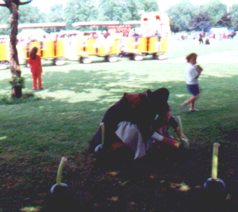
Foreground: System by Clare Calvert Placing and replacing 4 watermelons topped with leeks around the Bermondsey Carnival. |
With performances happening in seven locations, often simutaneously, in and around the carnival, you could only see aspects of the whole happening. The first performance I encountered was by Clare Calvert. Wearing a Welsh costume, she was busy making re-placements on the grass around the carnival with 4 watermelons each topped by a leek. She was easy to approach and told me that she was just moving them around the carnival to see what would happen. I liked the idea of a woman moving around melons in some sort of system around the carnival grounds in contrast and in reaction to the wanderings of the public around her. It was bizzare and witty. |
||||||||||||||||||||||||||||||||||||||||||||||||||||||||||||||||||||||||||||||||||||||||||||||||||
|
'Art is what you find in the meadows' was a performance by the Polish artist, Robert Sot. He scurried around in the undergrowth in the Cafe Gallery garden, more or less where I'd been balanced on a ladder a day earlier hanging one of my 'Big Ones'. He sniffed and scrapped at the ground like a dog and then started to dig. He found an oil painting on canvas that looked like it could be a self-portrait done in the style of 18th century romanticism. He cleaned it by blowing over it and carefully pulled it out and then placed it by the entrance of the gallery. People clapped.
Jana Winderen and two sound artists, (Norway), made a sound piece that could be heard on headphones that were hung on the bench in the same garden. The sounds distorted or intensified natural insect and human sounds, and affected your perception of that small garden on the edge of the noisy carnival. Initially she told me that she wanted people to be able to walk around wearing the headphones but the noise of the carnival made it impossible for the sounds to be transmitted. Actually I liked it that you had to sit and listen to these intense yet quiet sounds, aware that all around on the other side of those walls there was a carnival in full swing. The experience intensified the feeling that you were inside a cocoon. |
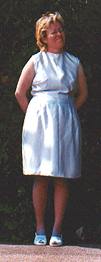
|
Fran Cottell's performance, "in situ PIPE" began with her standing in a silk white dress and white shoes on the green at the front of the gallery as if she was waiting for someone. Then the dress started to turn blue and blue leaked down her white stockings to her shoes. Then every so often a burst of blue water shot out above her head. The piece ended when her whole attire had turned sky blue.
A small crowd gathered around her once her dress was wet and then others came to see what the crowd was watching. |
| |||||||||||||||||||||||||||||||||||||||||||||||||||||||||||||||||||||||||||||||||||||||||||||||||
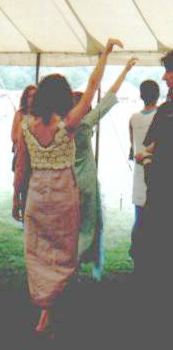
Traxis was a dance-movement performed by two British women in long dresses who moved slowly and gracefully around the tent space as well as the carnival stalls and public.
"We aim to amplify stillness as an equal force to movement"
It was beautiful to watch her do her best to balance the balls in the slings and to see if they remained in balance or fell and broke. | Debbie Sutherland's performance, "Ping Pong" in the Cafe Gallery consisted of a her attempting to hang plaster-of-paris balls of various sizes in rubber slings for a period of a few hours. Since the slings were made of rubber the balls often fell. She continued this act until all the 50 or so balls were either hanging or broken. |
|
|
| The Norwegian threesome, Trond Vangem, performed 'Body Beach 2000', in cabaret style. They asked a member the public to throw a dart onto a board. Where it landed determined the song they then sang, with actions. Most were in Norwegian, with explanations. The few in English were full of puns. There was a large audience and lots of laughter and clapping. | ||||||||||||||||||||||||||||||||||||||||||||||||||||||||||||||||||||||||||||||||||||||||||||||||||
|
Then immediately after this we walked one by one into the space that had been their 'stage' placed a row of chairs in a half-circle from the centre to the side. Then we each sat with a drawing pad and a pen and proceeded to draw the audience. After some silence, some laughter; after the expectation that something would happen, passed, people stood up and either walked away or walked around us to see what we drawing. |
| ||||||||||||||||||||||||||||||||||||||||||||||||||||||||||||||||||||||||||||||||||||||||||||||||||
Sitting, concentrating on what went by and drawing, was what we did. We were reversing the usual audience-performer relationship as well as dispersing the binary passive-active relationship. The audience watched us. We observed them. Sometimes they asked us a question. Sometimes we smiled at each other, but generally they silently walked around us, observing us, observing them. |
|
| ||||||||||||||||||||||||||||||||||||||||||||||||||||||||||||||||||||||||||||||||||||||||||||||||||
|
Their mission was to collect things from around the park and bring them back to the centre of the star, a disused swimming pool next to the gallery. They were instructed to find an object of a particular colour or form and they were to walk outwards from the pool in a direct line until they found this, even if it meant walking beyond the limits of the park. Once they found it, they had to take it back creating another line back to the pool. The purpose of the performance was to find and to collect and not to interact with the public, but people gathered around them and followed them because of their unusual actions and dress. |
| ||||||||||||||||||||||||||||||||||||||||||||||||||||||||||||||||||||||||||||||||||||||||||||||||||
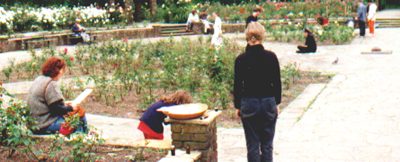
|
Our performance, 'The Living Creature' occurred on the third day. The performance lasted for one hour, followed by a one-hour break, and was then repeated for another hour. We wanted people to quietly interact and not have a situation where there was an expectation for some sort of entertainment and hence we chose the rose garden, set on the other side of the Gallery from the carnvial, for our location. | ||||||||||||||||||||||||||||||||||||||||||||||||||||||||||||||||||||||||||||||||||||||||||||||||||
|
Here our aim was to create the feeling of a community or collective of individuals rather than a group engaged in a common act so that when people entered the rose garden, their encounter with 'The Living Creature' was first with one person and then another, in various ways. It is hard to assess InterAction because I experienced it in snatches and in the shadow of the carnival. I found the more conceptual work more interesting and yet the more theatrical performances had more appeal for most of the public who were at a carnival afterall. It was an ambitious project, to create an arts event with an experimental edge in the midst and in the shadow of a huge carnival and I think on the whole it had something to offer for everyone, from teenagers having fun (often at the art) to the reflective park stroller. The most successful piece for me were a group of about 15 who performed on the open field in the middle of the carnival for about an hour. You noticed them only after a second look, because at first glance they could just being standing around just like any carnival goer. Then it dawned that some stood on that spot for a long time and others moved in unison. The longer I looked the larger the group seemed to become as others who at first seemed to be bystanders also moved. It was a tight choreography of subtle movements. It was nice when the public walked through the space of this performance. |